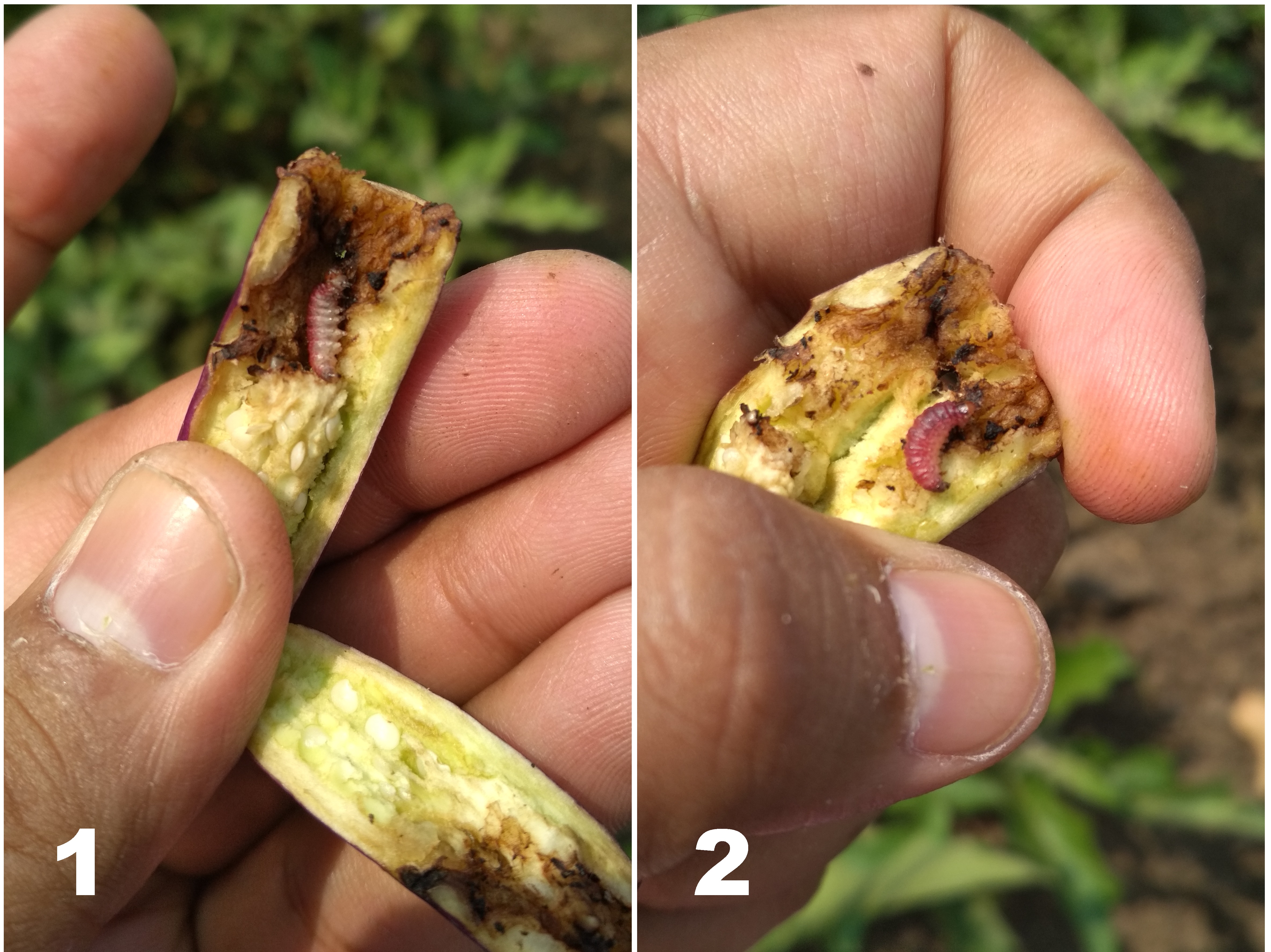By: Chandler Brotak, Isabel Arjmand, and Uri Bram
Norman Borlaug, the “father of the green revolution,” transformed agriculture (and won a Nobel Peace Prize) for developing new wheat varietals that resisted diseases and greatly increased yields.
You might well wonder: if it’s possible for wheat, is it possible for other crops? Consider the eggplant: a popular purple fruit/vegetable that can be made into everything from hongshao qiezi to baba ghanoush. It’s beloved by many people worldwide, and also by a cute but destructive moth larva:

An eggplant fruit and shoot borer larva inside an eggplant fruit. Photo credit: Chirag85 – Own work, CC BY-SA 4.0, via Wikimedia Commons
The “eggplant fruit and shoot borer,” as the name suggests, bores into the shoots and fruit of eggplants, damaging the crops. A new varietal, Bt eggplants, was developed by the Maharashtra Hybrid Seed Company (Mahyco), and later supported by partnerships with USAID, Cornell University, and local partners.1Shelton et al. 2019, pp. 4-5. This varietal is genetically modified to create proteins which are toxic to these little menaces, but safe for humans and the environment.
So: could encouraging the adoption of Bt eggplants create a purple revolution that meets GiveWell’s bar for outstanding programs?
Based on preliminary research, we don’t believe so.
Two of the major considerations in our evaluation framework are whether the intervention is cost-effective and whether we believe it has room for more funding.
For cost-effectiveness, we attempt to quantify the costs and benefits of each intervention we investigate. In the case of Bt eggplants, the main effects of the program that we consider are increased yields and decreased costs for eggplant farmers. A randomized controlled trial conducted in Bangladesh from 2017-2018 found that Bt eggplants increased yields by about 50% and reduced pesticide costs by about 40%,2GiveWell, Bt eggplant adoption short note increasing their total profits by about 60%.3GiveWell, Genetically modified eggplants BOTEC
At GiveWell, we benchmark programs against the benefit of one of the simplest interventions out there: giving people cash. Our research implied that encouraging farmers to adopt Bt eggplants was indeed more cost-effective than the benchmark, largely through the increase in farmer income.4GiveWell, Genetically modified eggplants BOTEC However, it was only about 3x more cost-effective than cash, and it would need to be at least 10x more cost-effective than cash to reach our current funding bar. While our Bt eggplant estimate of 3x is a rough appraisal and shouldn’t be taken too literally, we don’t expect to recommend funding to it given current information.
For room for more funding, we try to assess whether there is a mechanism for turning additional funding in the area into additional impact. If an intervention is cost-effective in principle but already fully funded by someone else, then pushing additional money towards it would not actually help. In this case, USAID is currently supporting Bt eggplant adoption through the Insect-Resistant Eggplant Partnership, and our shallow investigation of other funders in the space didn’t come across any clear funding gaps for commercialization in low- or middle-income countries.
Some readers might be surprised to hear that GiveWell—whose current top charities focus on malaria, vaccines, and vitamin A for children—would even be investigating an intervention like eggplants. In fact, we’re open to supporting any kind of intervention that saves or improves people’s lives. The most cost-effective interventions we have found so far largely involve health interventions for children in low- and middle-income countries; however, we’re constantly on the lookout for other interventions that might meet our funding bar.
With our limited funding and researcher time, we have to carefully prioritize where we spend our attention: we can’t fully investigate every project, even if there’s potential that with further research a project would indeed prove fruitful. As such, we’re not planning further work on eggplants at present. We’d certainly be open to reconsidering our assessment of Bt eggplants if we got relevant new information. In the meantime, if this post has got you hungry, we recommend this brinjal recipe.5This is not an official GiveWell recommendation and has not undergone any kind of cost-benefit analysis
Notes
| ↑1 | Shelton et al. 2019, pp. 4-5. |
|---|---|
| ↑2 | GiveWell, Bt eggplant adoption short note |
| ↑3 | GiveWell, Genetically modified eggplants BOTEC |
| ↑4 | GiveWell, Genetically modified eggplants BOTEC |
| ↑5 | This is not an official GiveWell recommendation and has not undergone any kind of cost-benefit analysis |
